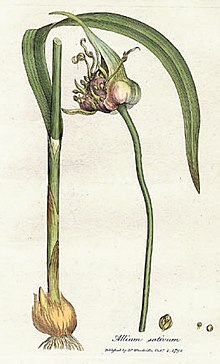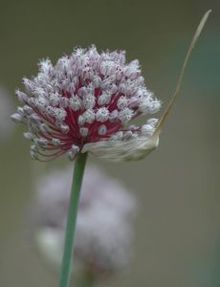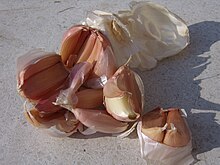Garlic (Allium sativum) is a species of bulbous flowering plant in the onion genus Allium. Its close relatives include the onion, shallot, leek, chive,[2] Welsh onion and Chinese onion.[3] It is native to Central Asia and northeastern Iran and has long been a common seasoning worldwide, with a history of several thousand years of human consumption and use.[4][5] It was known to ancient Egyptians and has been used as both a food flavoring and a traditional medicine.[6][7] China produces 76% of the world's supply of garlic.[8]
Etymology
The word garlic derives from Old English, garlēac, meaning gar (spear) and leek, as a 'spear-shaped leek'.[9]
Description
Allium sativum is a perennial flowering plant growing from a bulb. It has a tall, erect flowering stem that grows up to 1 m (3 ft). The leaf blade is flat, linear, solid, and approximately 1.25–2.5 cm (0.5–1.0 in) wide, with an acute apex. The plant may produce pink to purple flowers from July to September in the Northern Hemisphere. The bulb is odoriferous and contains outer layers of thin sheathing leaves surrounding an inner sheath that encloses the clove. Often the bulb contains 10 to 20 cloves that are asymmetric in shape, except for those closest to the center.[6] If garlic is planted at the proper time and depth, it can be grown as far north as Alaska.[10] It produces hermaphrodite flowers. It is pollinated by bees, butterflies, moths, and other insects.[11]
Origin and major types
Identification of the wild progenitor of common garlic is difficult due to the sterility of its many cultivars, which limits the ability to cross test with wild relatives. Genetically and morphologically, garlic is most similar to the wild species Allium longicuspis, which grows in central and southwestern Asia.[12][13][14] However, because Allium longicuspis is also mostly sterile, it is doubtful that it is the ancestor of Allium sativum.[12] Other candidates that have been suggested include Allium tuncelianum, Allium macrochaetum, and Allium truncatum, all of which are native to the Middle East.[12]
Allium sativum grows in the wild in areas where it has become naturalized. The "wild garlic", "crow garlic", and "field garlic" of Britain are members of the species Allium ursinum, Allium vineale, and Allium oleraceum, respectively. In North America, Allium vineale (known as "wild garlic" or "crow garlic") and Allium canadense (known as "meadow garlic", "wild garlic", or "wild onion") are common weeds in fields.[15] So-called elephant garlic is actually a wild leek (Allium ampeloprasum), and not a true garlic. Single clove garlic (also called pearl or solo garlic) originated in the Yunnan province of China.
European garlic
Some garlics have protected status in Europe,[16] including:
Subspecies and varieties
There are two subspecies of A. sativum,[17] ten major groups of varieties, and hundreds of varieties or cultivars.
- A. sativum var. ophioscorodon (Link) Döll, called Ophioscorodon, or hard-necked garlic, includes porcelain garlics, rocambole garlic, and purple stripe garlics. It is sometimes considered to be a separate species, Allium ophioscorodon G.Don.
- A. sativum var. sativum, or soft-necked garlic, includes artichoke garlic, silverskin garlic, and creole garlic.
There are at least 120 cultivars originating from Central Asia, making it the main center of garlic biodiversity.[18]
Cultivation
Garlic is easy to grow and can be grown year-round in mild climates.[19] While sexual propagation of garlic is possible, nearly all of the garlic in cultivation is propagated asexually, by planting individual cloves in the ground.[13] In colder climates, cloves are best planted about six weeks before the soil freezes. The goal is to have the bulbs produce only roots and no shoots above the ground.[20] Harvest is in late spring or early summer.
Garlic plants can be grown closely together, leaving enough space for the bulbs to mature, and are easily grown in containers of sufficient depth. Garlic does well in loose, dry, well-drained soils in sunny locations, and is hardy throughout USDA climate zones 4–9. When selecting garlic for planting, it is important to pick large bulbs from which to separate cloves. Large cloves, along with proper spacing in the planting bed, will also increase bulb size. Garlic plants prefer to grow in a soil with a high organic material content, but are capable of growing in a wide range of soil conditions and pH levels.[13]
There are different varieties or subspecies of garlic, most notably hardneck garlic and softneck garlic.[19] The latitude where the garlic is grown affects the choice of type, as garlic can be day-length sensitive. Hardneck garlic is generally grown in cooler climates and produces relatively large cloves, whereas softneck garlic is generally grown closer to the equator and produces small, tightly-packed cloves.[19]
Garlic scapes are removed to focus all the garlic's energy into bulb growth. The scapes can be eaten raw or cooked.[21][22]
Diseases
Garlic plants are usually hardy and not affected by many pests or diseases. Garlic plants are said to repel rabbits and moles.[3] The California Department of Food and Agriculture (CDFA) conducts a certification program to assure freedom from nematode and white rot disease caused by Stromatinia cepivora, two pathogens that can both destroy a crop as well as remain in the soil indefinitely, once introduced.[13] Garlic may also suffer from pink root, a typically non-fatal disease that stunts the roots and turns them pink or red;[23] or leek rust.[19] The larvae of the leek moth attack garlic by mining into the leaves or bulbs.[24]
Production
In 2019, world production of garlic was 31 million tonnes, with China alone accounting for 76% of the total.[8]
Properties
Fresh or crushed garlic yields the sulfur-containing compounds allicin, ajoene, diallyl polysulfides, vinyldithiins, and S-allylcysteine; as well as enzymes, saponins, flavonoids, and Maillard reaction products, which are not sulfur-containing compounds.
The phytochemicals responsible for the sharp flavor of garlic are produced when the plant's cells are damaged. When a cell is broken by chopping, chewing, or crushing, enzymes stored in cell vacuoles trigger the breakdown of several sulfur-containing compounds stored in the cell fluids (cytosol).[25] The resultant compounds are responsible for the sharp or hot taste and strong smell of garlic. Some of the compounds are unstable and continue to react over time.[26]
Among the members of the onion family, garlic has by far the highest concentrations of initial reaction products, making garlic much more potent than onion, shallot, or leeks.[27] Although many humans enjoy the taste of garlic, these compounds are believed to have evolved as a defensive mechanism, deterring animals such as birds, insects, and worms from eating the plant.[28]
A large number of sulfur compounds contribute to the smell and taste of garlic. Allicin has been found to be the compound most responsible for the "hot" sensation of raw garlic. This chemical opens thermo-transient receptor potential channels that are responsible for the burning sense of heat in foods. The process of cooking garlic removes allicin, thus mellowing its spiciness.[28] Allicin, along with its decomposition products diallyl disulfide and diallyl trisulfide, are major contributors to the characteristic odor of garlic, with other allicin-derived compounds, such as vinyldithiins and ajoene.[2]
Because of its strong odor, garlic is sometimes called the "stinking rose". When eaten in quantity, garlic may be strongly evident in the diner's sweat and garlic breath the following day. This is because garlic's strong-smelling sulfur compounds are metabolized, forming allyl methyl sulfide. Allyl methyl sulfide (AMS) cannot be digested and is passed into the blood. It is carried to the lungs and the skin, where it is excreted. Since digestion takes several hours, and release of AMS several hours more, the effect of eating garlic may be present for a long time.[2]
The well-known phenomenon of "garlic breath" is allegedly alleviated by eating fresh parsley.[29] The herb is, therefore, included in many garlic recipes, such as pistou, persillade, and the garlic butter spread used in garlic bread.
Abundant sulfur compounds in garlic are also responsible for turning garlic green or blue during pickling and cooking. Under these conditions (i.e., acidity, heat) the sulfur-containing compound alliin reacts with common amino acids to make pyrroles, clusters of carbon-nitrogen rings.[30][31] These rings can be linked together into polypyrrole molecules. Ring structures absorb particular wavelengths of light and thus appear colored. The two-pyrrole molecule looks red, the three-pyrrole molecule looks blue, and the four-pyrrole molecule looks green (like chlorophyll, a tetrapyrrole). Like chlorophyll, the pyrrole pigments are safe to eat.[32] Upon cutting, similar to a color change in onion caused by reactions of amino acids with sulfur compounds,[33] garlic can turn green.[34][35]
Because of sulfur compounds circulating in blood, consumed garlic may act as a mosquito repellent, but there is no scientific evidence garlic is effective for this purpose.[36]
History

Culinary
Numerous cuneiform records show that garlic has been cultivated in Mesopotamia for at least 4,000 years.[12] The use of garlic in China and Egypt also dates back thousands of years.[2][12] Well-preserved garlic was found in the tomb of Tutankhamun (c. 1325 BC).[12] It was consumed by ancient Greek and Roman soldiers, sailors, and rural classes (Virgil, Eclogues ii. 11), and, according to Pliny the Elder (Natural History xix. 32), by the African peasantry. Garlic was placed by the ancient Greeks on the piles of stones at crossroads, as a supper for Hecate (Theophrastus, Characters, The Superstitious Man).
Garlic was rare in traditional English cuisine (though it is said to have been grown in England before 1548) but has been a common ingredient in Mediterranean Europe.[37] Translations of the c. 1300 Assize of Weights and Measures, an English statute generally dated to the 13th century, indicate a passage as dealing with standardized units of garlic production, sale, and taxation — the hundred of 15 ropes of 15 heads each[38] – but the Latin version of the text may refer to herring rather than garlic.[39]
Folk medicine
Garlic has been used for traditional medicine in diverse cultures such as in Egypt, Japan, China, Rome, and Greece.[40] In his Natural History, Pliny gave a list of conditions in which garlic was considered beneficial (N.H. xx. 23). Galen, writing in the second century, eulogized garlic as the "rustic's theriac" (cure-all) (see F. Adams' Paulus Aegineta, p. 99). Avicenna, in The Canon of Medicine (1025), recommended garlic for the treatment of arthritis, snake and insect bites, parasites, chronic cough, and as an antibiotic.[medical citation needed] Alexander Neckam, a writer of the 12th century (see Wright's edition of his works, p. 473, 1863), discussed it as a palliative for the heat of the sun in field labor. In the 17th century, Thomas Sydenham valued it as an application in confluent smallpox, and William Cullen's Materia Medica of 1789 found some dropsies cured by it alone







No comments: